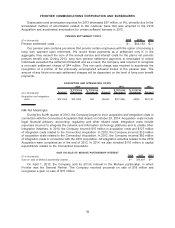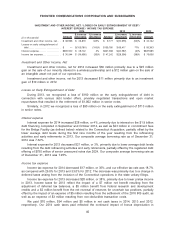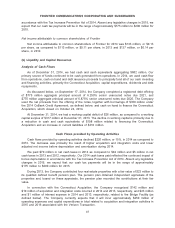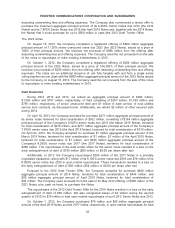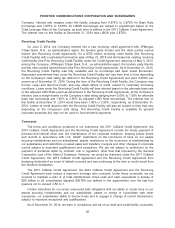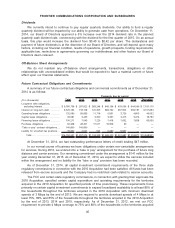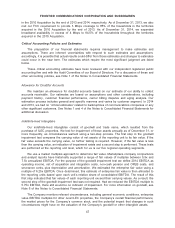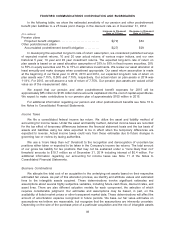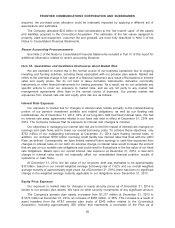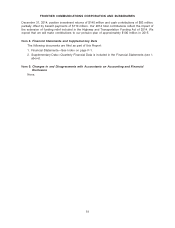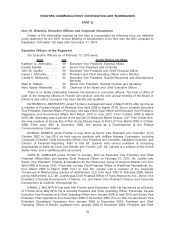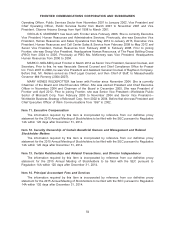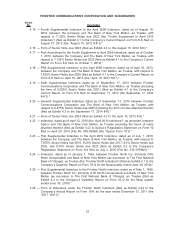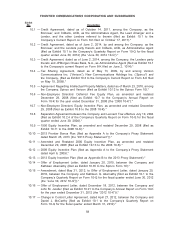Frontier Communications 2014 Annual Report Download - page 49
Download and view the complete annual report
Please find page 49 of the 2014 Frontier Communications annual report below. You can navigate through the pages in the report by either clicking on the pages listed below, or by using the keyword search tool below to find specific information within the annual report.Depreciation and Amortization
The calculation of depreciation and amortization expense is based upon the estimated useful lives
of the underlying property, plant and equipment and identifiable finite-lived intangible assets.
Depreciation expense is principally based on the composite group method for substantially all of our
property, plant and equipment assets. The estimates for remaining lives of the various asset categories
are determined annually, based on an independent study. Among other considerations, these studies
include models that consider actual usage, replacement history and assumptions about technology
evolution for each category of asset. The latest study was completed in the fourth quarter of 2014 and
did not result in any significant changes in remaining lives for any of our asset categories. A one year
decrease in the estimated useful lives of our property, plant and equipment would result in an increase
of approximately $100 million to depreciation expense.
Our finite-lived intangibles consist principally of customer base; $2.5 billion from the 2010
Acquisition and $590 million from the recently completed Connecticut Acquisition. These customer
bases are being amortized on an accelerated method because this method most closely resembles the
projected underlying revenue streams. In assigning lives, which range from between nine and
12 years, a separate evaluation and determination is made for residential and business customers.
See Notes 5 and 6 of the Notes to Consolidated Financial Statements for additional discussion.
Asset Impairments
We review long-lived assets to be held and used, including customer lists, and long-lived assets to
be disposed of for impairment at least annually or whenever events or changes in circumstances
indicate that the carrying amount of such assets may not be recoverable. Recoverability of assets to be
held and used is measured by comparing the carrying amount of the asset to the estimated fair value,
which is based on the future undiscounted net cash flows expected to be generated by the asset.
Recoverability of assets held for sale is measured by comparing the carrying amount of the assets to
their estimated fair market value. If any assets are considered to be impaired, the impairment is
measured by the amount by which the carrying amount of the assets exceeds the estimated fair value.
Also, we periodically reassess the useful lives of our tangible and intangible assets to determine
whether any changes are required.
Pension and Other Postretirement Benefits
We sponsor a defined benefit pension plan covering a significant number of our current and former
employees as well as other postretirement benefit plans that provide medical, dental, life insurance and
other benefits for covered retired employees and their beneficiaries and covered dependents. As of
December 31, 2014, the unfunded benefit obligation for these plans recorded on our consolidated
balance sheet was $1.3 billion. During 2014, we contributed $95 million to these plans and recorded
$74 million of expense before capitalization. Pension and other postretirement benefit costs and
obligations are dependent upon various actuarial assumptions, the most significant of which are the
discount rate and the expected long-term rate of return on plan assets.
Our discount rate assumption is determined annually with assistance from our actuaries based on
the pattern of expected future benefit payments and the prevailing rates available on long-term, high
quality corporate bonds with durations approximate to that of our benefit obligation. As of December 31,
2014 and 2013, we utilized an estimation technique that is based upon a settlement model (Bond:Link)
that permits us to closely match cash flows to the expected payments to participants. This rate can
change from year-to-year based on market conditions that affect corporate bond yields.
We are utilizing a discount rate of 4.10% as of December 31, 2014 for our qualified pension plan,
compared to rates of 4.90% and 4.00% in 2013 and 2012, respectively. The discount rate for
postretirement plans as of December 31, 2014 was a range of 4.10% to 4.20% compared to a range of
4.90% to 5.20% in 2013 and 4.00% to 4.20% in 2012.
48
FRONTIER COMMUNICATIONS CORPORATION AND SUBSIDIARIES



